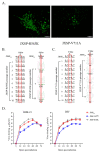Amino Acid Substitutions in NS5 Contribute Differentially to Tembusu Virus Attenuation in Ducklings and Cell Cultures
- PMID: 34065634
- PMCID: PMC8156267
- DOI: 10.3390/v13050921
Amino Acid Substitutions in NS5 Contribute Differentially to Tembusu Virus Attenuation in Ducklings and Cell Cultures
Abstract
Tembusu virus (TMUV), a highly infectious pathogenic flavivirus, causes severe egg-drop and encephalitis in domestic waterfowl, while the determinants responsible for viral pathogenicity are largely unknown. In our previous studies, virulent strain JXSP2-4 had been completely attenuated by successive passages in BHK-21 cells and the avirulent strain was designated as JXSP-310. Based on the backbone of JXSP2-4, a series of chimeric viruses were generated according to the amino acid substitutions in NS5 and their infectivities were also analyzed in cell cultures and ducklings. The results showed that the viral titers of RNA-dependent RNA polymerase (RdRp) domain-swapped cheimeric mutant (JXSP-310RdRp) in cells and ducklings were both markedly decreased compared with JXSP2-4, indicating that mutations in the RdRp domain affected viral replication. There are R543K and V711A two amino acid substitutions in the RdRp domain. Further site-directed mutagenesis showed that single-point R543K mutant (JXSP-R543K) exhibited similar replication efficacy compared with JXSP2-4 in cells, but the viral loads in JXSP-R543K-infected ducklings were significantly lower than that of JXSP2-4 and higher than JXSP-310RdRp. Surprisingly, the single-point V711A mutation we introduced rapidly reverted. In addition, qRT-PCR and Western blot confirmed that the mutations in the RdRp domain significantly affected the replication of the virus. Taken together, these results show that R543K substitution in the RdRp domain impairs the in vivo growth of TMUV, but sustaining its attenuated infectivity requires the concurrent presence of the V711A mutation.
Keywords: RNA-dependent RNA polymerase; Tembusu virus; attenuation; chimeric viruses; viral replication.
Conflict of interest statement
The authors declare no conflict of interest.
Figures








Similar articles
-
Long-term passage of duck Tembusu virus in BHK-21 cells generates a completely attenuated and immunogenic population with increased genetic diversity.Vaccine. 2020 Jan 22;38(4):933-941. doi: 10.1016/j.vaccine.2019.10.080. Epub 2019 Nov 8. Vaccine. 2020. PMID: 31708180
-
Basic Amino Acid Substitution at Residue 367 of the Envelope Protein of Tembusu Virus Plays a Critical Role in Pathogenesis.J Virol. 2020 Mar 31;94(8):e02011-19. doi: 10.1128/JVI.02011-19. Print 2020 Mar 31. J Virol. 2020. PMID: 32024774 Free PMC article.
-
An infectious full-length cDNA clone of duck Tembusu virus, a newly emerging flavivirus causing duck egg drop syndrome in China.Virus Res. 2013 Jan;171(1):238-41. doi: 10.1016/j.virusres.2012.10.019. Epub 2012 Oct 29. Virus Res. 2013. PMID: 23116594
-
Flavivirus RNA-Dependent RNA Polymerase Interacts with Genome UTRs and Viral Proteins to Facilitate Flavivirus RNA Replication.Viruses. 2019 Oct 10;11(10):929. doi: 10.3390/v11100929. Viruses. 2019. PMID: 31658680 Free PMC article. Review.
-
An updated review of avian-origin Tembusu virus: a newly emerging avian Flavivirus.J Gen Virol. 2017 Oct;98(10):2413-2420. doi: 10.1099/jgv.0.000908. Epub 2017 Sep 6. J Gen Virol. 2017. PMID: 28874226 Review.
Cited by
-
Comparative analysis of duck Tembusu virus Cluster 1 and Cluster 2.1 in Culex tritaeniorhynchus: Insights into viral characteristics, infectivity, and innate immune response.Curr Res Parasitol Vector Borne Dis. 2025 May 26;7:100274. doi: 10.1016/j.crpvbd.2025.100274. eCollection 2025. Curr Res Parasitol Vector Borne Dis. 2025. PMID: 40521371 Free PMC article.
-
Persistence of Tembusu Virus in Culex tritaeniorhynchus in Yunnan Province, China.Pathogens. 2023 Mar 21;12(3):490. doi: 10.3390/pathogens12030490. Pathogens. 2023. PMID: 36986412 Free PMC article.
-
Pathogenesis of Cluster 1 Duck Tembusu Virus in Ducks Reveals the Impact of Viral Genotype on Pathogenicity and Disease Severity.Transbound Emerg Dis. 2023 Nov 28;2023:9239953. doi: 10.1155/2023/9239953. eCollection 2023. Transbound Emerg Dis. 2023. PMID: 40303729 Free PMC article.
-
Identification of the Tembusu Virus in Mosquitoes in Northern Thailand.Viruses. 2023 Jun 27;15(7):1447. doi: 10.3390/v15071447. Viruses. 2023. PMID: 37515135 Free PMC article.
References
-
- Liu P., Lu H., Li S., Moureau G., Deng Y.Q., Wang Y., Zhang L., Jiang T., de Lamballerie X., Qin C.F., et al. Genomic and antigenic characterization of the newly emerging Chinese duck egg-drop syndrome flavivirus: Genomic comparison with Tembusu and Sitiawan viruses. J. Gen. Virol. 2012;93:2158–2170. doi: 10.1099/vir.0.043554-0. - DOI - PubMed
Publication types
MeSH terms
Substances
Supplementary concepts
LinkOut - more resources
Full Text Sources
Molecular Biology Databases
Research Materials

